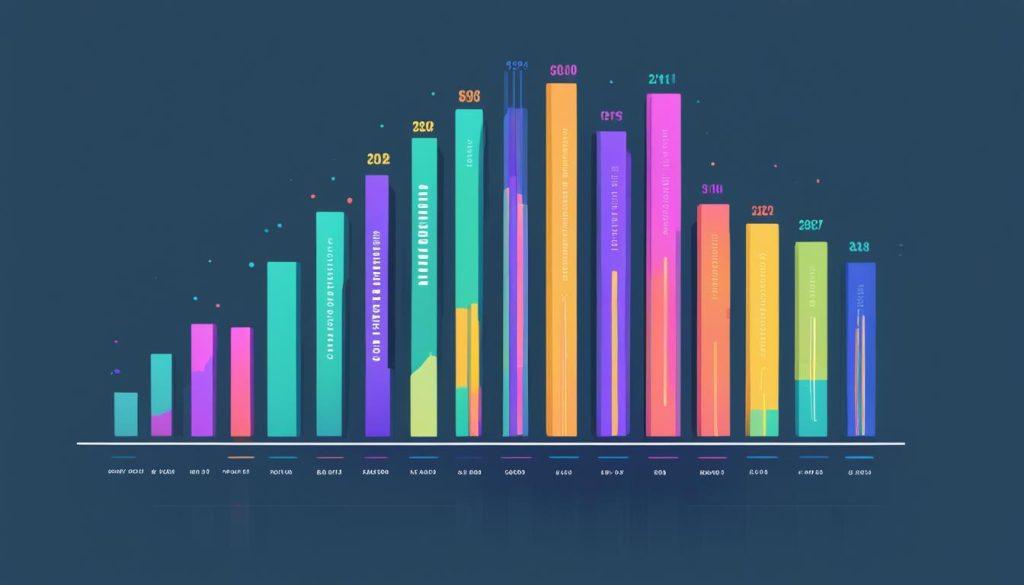This post may contain affiliate links. As an Amazon associate, Google associate as well as associate for other programs, Guitar & Music Institute may earn commissions from qualifying purchases.

According to recent data, the average annual earnings for American musicians vary depending on factors such as location and level of success. In this article, we will explore the current data on what the average American musician earns in a year and understand the industry’s salary dynamics.
Key Takeaways:
- Average American musicians have varying salaries that are influenced by factors such as location and level of success.
- Understanding the average musician salary in the US can provide valuable insights to musicians looking to maximize their earning potential.
- Income streams, such as touring, merchandise sales, and collaborations, play a significant role in an artist’s earning potential.
- The music industry has seen a shift in revenue sources, with streaming becoming a dominant source of income.
- Independent musicians have the opportunity to expand their earning potential through diverse revenue streams, such as songwriting and producing.
Highest Paying States for Musicians
When it comes to earning a living as a musician, location can significantly impact your income. Data from the first source reveals the highest paying states for musicians in the United States, providing valuable insights into salary differences that can help musicians maximize their earning potential.
In terms of average annual earnings, New York takes the top spot, offering musicians an average income of $87,177. This bustling state, known for its vibrant music scene, presents numerous opportunities for musicians to perform and collaborate.
Following closely is Connecticut, where musicians earn an average of $77,569 per year. This state offers a thriving music community and ample performance venues, contributing to the higher than average earnings for musicians.
Next on the list is California, with musicians earning an average of $79,675 annually. With its rich cultural diversity and renowned music industry, California attracts talented musicians from all genres.
These figures demonstrate the salary differences among different states, emphasizing the importance of considering location when pursuing a career in music. Musicians aspiring to earn higher incomes may find these statistics helpful in making informed decisions about where to establish themselves and pursue opportunities in the industry.
Highest Paying States for Musicians
| State | Average Annual Earnings |
|---|---|
| New York | $87,177 |
| Connecticut | $77,569 |
| California | $79,675 |
As the table demonstrates, these states offer some of the highest average musician earnings in the United States. Musicians seeking both financial stability and artistic opportunities may find these states to be promising destinations.
With these insights into the highest paying states for musicians, aspiring artists can strategically plan their careers and explore the regions that provide the greatest earning potential.
Independent Musicians’ Earnings
When it comes to independent musicians, their earnings can greatly fluctuate based on their level of success and the number of income streams they have. While the median salary for an indie musician falls around $12,860 per year, some musicians are able to generate significantly higher income through various avenues.
One of the key factors influencing an independent musician’s earnings is the diversification of their revenue sources. By expanding beyond traditional streams, such as album sales and live performances, musicians can tap into a range of income streams available in today’s digital landscape.
The following table provides an overview of potential income streams for independent musicians:
| Income Stream | Description |
|---|---|
| Streaming | Earn revenue from platforms like Spotify, Apple Music, and YouTube through streams of your music. |
| Royalties | Collect royalties from songwriting credits, performance rights organizations (PROs), and licensing deals. |
| Merchandise Sales | Create and sell merchandise like t-shirts, posters, and vinyl records to your fans. |
| Touring | Generate income from ticket sales, live performances, and merchandise sales during tours and concerts. |
| Sync Licensing | License your music to be used in films, TV shows, commercials, and other media projects. |
| Brand Collaborations | Partner with brands for endorsements, sponsored content, and product placements. |
These are just a few examples of the income streams available to independent musicians. By diversifying their revenue sources, musicians can increase their earning potential and create a sustainable career in the industry.
Music Industry Revenue and Streaming
According to the third source’s data, the music industry has experienced significant shifts in its revenue sources. While physical and digital music sales have seen a decline, streaming has emerged as a dominant force, contributing billions of dollars to the industry’s revenue. In 2022, streaming revenue reached an impressive $13.3 billion, a drastic increase from $4 billion in 2016. This growth can be attributed to the widespread availability of streaming services and the widespread use of smartphones.
The rise of music streaming platforms has revolutionized the way people consume music, offering instant access to a vast library of songs. With just a few clicks, listeners can enjoy their favorite tracks anytime, anywhere, without the need to purchase physical albums or digital downloads. This shift in consumer behavior has had a profound impact on the music industry’s revenue streams.
Table: Music Industry Revenue Comparison
| Year | Physical Album Sales | Digital Music Sales | Streaming Revenue |
|---|---|---|---|
| 2016 | $10.1 billion | $7.8 billion | $4 billion |
| 2022 | $3.2 billion | $1.5 billion | $13.3 billion |
As shown in the table, physical album sales and digital music sales have seen a significant decline over the years, while streaming revenue has skyrocketed. This data underscores the growing popularity of streaming services and the shift towards digital consumption.
Music streaming has provided artists and record labels with new opportunities to monetize their content. Streaming platforms pay royalties to artists based on the number of streams their songs receive, allowing for potential earnings on a global scale. While the revenue per stream may be small, the sheer volume of streams can generate substantial income for popular artists.
The rise of streaming has transformed the music industry, offering unprecedented access to music for listeners and new revenue streams for artists.
The convenience and affordability of streaming have attracted a vast audience, resulting in a significant boost in revenue for the music industry as a whole. The continued growth of streaming services presents both challenges and opportunities for artists and industry professionals. It is crucial for musicians to adapt to this evolving landscape and explore strategies to optimize streaming revenue while maintaining a loyal fan base.
The rapid growth of streaming revenue in the music industry suggests that this trend will continue to shape the industry’s future. As technology advances and streaming platforms refine their offerings, opportunities for artists and record labels to generate revenue from streaming will likely expand further.
In summary, the music industry’s revenue has shifted dramatically with the rise of streaming. While physical and digital music sales have declined, streaming has become a major source of income, with massive revenue growth in recent years. Artists and industry professionals must adapt to this new landscape and leverage streaming platforms to maximize their earning potential.
Music Publishing and Distribution Giants
The music industry is heavily influenced by the major players in music publishing and distribution. These companies not only generate substantial revenue through recorded music but also hold significant sway over the industry as a whole. Two of the biggest names in the industry are Warner Chappell and Universal Music Group, alongside Sony/ATV, collectively accounting for over 50% of music publishing revenues globally.
Warner Chappell, a subsidiary of Warner Music Group, is one of the largest music publishing companies in the world. They work closely with songwriters and artists to protect and promote their creative works. With an extensive catalog of popular music, Warner Chappell plays a crucial role in ensuring that artists receive the royalties they deserve.
Universal Music Group, a subsidiary of French media conglomerate Vivendi, is another major player in the music publishing and distribution industry. They represent some of the most prominent artists in the world and have an extensive global reach. Universal Music Group works not only with established artists but also nurtures emerging talent, allowing them to reach a broader audience.
Sony/ATV, a joint venture between Sony Music Entertainment and the Estate of Michael Jackson, is yet another influential music publishing giant. With a vast catalog of successful songs, including classics from the likes of The Beatles and Bob Dylan, Sony/ATV undoubtedly holds significant sway in the industry. The company’s ability to protect and monetize its extensive repertoire contributes to its strong market presence.
Independent Music Publishers and Niche Offerings
Though major music publishing companies dominate the industry, independent music publishers have gained interest for their niche offerings. These independent publishers often specialize in specific music genres or cater to unique artist needs. While their market share remains limited compared to the industry giants, independent music publishers provide an avenue for artists to explore alternative publishing options that may better align with their artistic vision.
“The rise of independent music publishers provides artists with more choices and the ability to maintain greater control over their music careers.”
These independent music publishers, such as Kobalt Music Group and Downtown Music Publishing, focus on nurturing the careers of emerging artists and providing them with personalized support and resources. By offering tailored services, independent music publishers are able to adapt quickly to industry trends and artist demands, further enhancing their appeal.
While major record labels and distributors continue to dominate the music publishing landscape, the emergence of independent music publishers brings fresh perspectives and opportunities for artists in the industry. By diversifying the music publishing ecosystem, musicians have more options to showcase their talent and reach their desired audiences.
Revenue Opportunities for Independent Musicians
The music industry offers various revenue opportunities for independent musicians to increase their earnings and establish a successful career. In addition to their own music releases, indie musicians can explore additional avenues that contribute to their financial growth. The second source provides valuable insights into these revenue opportunities, including:
Songwriting for Other Artists
One lucrative opportunity for independent musicians is songwriting for other artists. Collaborating with well-known artists can lead to significant financial rewards if the song becomes a hit. Independent songwriters can earn anywhere from a few thousand to six figures for their contributions, depending on the popularity and success of the song.
Producing for Other Artists
Besides songwriting, producing for other artists is another notable revenue opportunity. Independent musicians with exceptional production skills can offer their services to other artists seeking professional production for their music. By leveraging their expertise and creativity, indie producers can generate income from producing tracks for various artists across different genres.
Touring Income
Touring is a significant source of income for musicians. Independent musicians can plan their own tours or join as supporting acts for established artists. Income from tours can vary widely depending on the scale, success, and popularity of the artist. Tours can range from a few thousand dollars to over $100,000, providing independent musicians with substantial earnings and increased visibility.
Overall, independent musicians have numerous revenue opportunities beyond their own music releases. Songwriting for other artists, producing tracks, and touring all contribute to their annual earnings and help establish a strong presence in the music industry.
| Revenue Opportunity | Potential Earnings |
|---|---|
| Songwriting for Other Artists | Varies from a few thousand to six figures |
| Producing for Other Artists | Depends on the project scope and artist’s budget |
| Touring Income | Ranges from a few thousand to over $100,000 |
Income Expectations for Independent Musicians
When embarking on a career as an independent musician, it’s crucial to manage income expectations effectively. The reality is that the first few years may not be financially lucrative, and it’s important to keep expectations in check to avoid disappointment.
While streaming royalties can be a potential income source, it’s important to note that smaller artists may not generate significant revenue from this channel alone. As such, it’s essential for independent musicians to explore and diversify their income avenues.
- Touring: Going on tour can be a significant source of income for independent musicians. By performing live shows and connecting with fans in person, musicians can generate substantial revenue through ticket sales and merchandise.
- Merch Sales: Creating and selling merchandise, such as t-shirts, posters, and albums, can provide a steady stream of income. Fans often enjoy supporting their favorite artists through merchandise purchases.
- Brand Deals: Collaborating with brands for endorsements, sponsorships, or partnerships can be a lucrative income opportunity for independent musicians. It’s important to align with brands that resonate with the artist’s values and image to maintain authenticity.
- Licensing Deals: Licensing music for use in commercials, films, TV shows, or video games can provide a stable income stream. Independent musicians should explore opportunities to license their music and reach broader audiences.
- Collaborations: Collaborating with other artists can expand an independent musician’s reach and income potential. By working together on projects or featuring on each other’s songs, musicians can tap into each other’s fan bases and increase exposure.
Beyond these income avenues, it’s crucial for independent musicians to continually build and cultivate their fan base. Engaging with fans through social media, email newsletters, and live shows can foster a loyal following, leading to increased support and revenue opportunities.
“Diversifying income streams is key for independent musicians. By exploring various avenues such as touring, merch sales, brand deals, licensing, and collaborations, artists can build a sustainable and thriving career.”
Managing financial expectations as a musician can be challenging, but with careful planning and a focus on diversifying income sources, independent musicians can create a stable financial foundation for their careers. By understanding the potential income streams available and building a strong and engaged fan base, musicians can navigate the industry with confidence and work towards long-term success.

Future Outlook for Independent Musicians
The future of the music industry holds exciting opportunities for independent musicians, offering the potential for growth and reaching a wider audience than ever before. With the rise of social media platforms, such as TikTok, indie musicians now have the chance to showcase their talent and gain exposure to a vast and engaged audience.
Social media platforms have become powerful tools for independent musicians to share their music, connect with fans, and attract attention from industry professionals. These platforms offer endless reach and the potential to go viral, propelling unknown artists into the spotlight and opening doors to future opportunities.
To make the most of these platforms, it is crucial for independent musicians to stay genuine and create engaging content that resonates with their target audience. By showcasing their unique musical style and personality, indie musicians can establish a loyal fanbase and build a strong online presence.
“Social media platforms like TikTok have provided indie musicians with an unprecedented opportunity to get their music heard by a wider audience. The ability to go viral on these platforms has opened doors for collaborations, brand partnerships, and even record deals.”
The future of the music industry is expected to rely increasingly on digital channels for revenue. Streaming platforms continue to dominate the industry, with music consumption shifting towards digital platforms rather than physical sales. This shift presents indie musicians with the chance to reach a global audience and earn income from streams, further expanding their earning potential.
With the continuous evolution of technology and the increasing popularity of social media, independent musicians have greater opportunities for growth and success. However, it is important for them to maintain a consistent online presence, engage with their fanbase, and adapt to the ever-changing landscape of the music industry.
Comparison of Social Media Platforms for Independent Musicians
| Platform | Key Features | Reach | Monetization Opportunities |
|---|---|---|---|
| TikTok | Short-form videos, viral challenges, music integration | Over 1 billion monthly active users worldwide | Brand partnerships, sponsorship deals, increased streaming revenue |
| Photo and video sharing, live streaming, Instagram Stories | Over 1 billion monthly active users worldwide | Merchandise sales, sponsored content, live performances | |
| YouTube | Video sharing, live streaming, YouTube Music | Over 2 billion monthly active users worldwide | Ad revenue, fan funding, merchandise sales |
The table above compares three popular social media platforms for independent musicians, highlighting their key features, reach, and monetization opportunities. Each platform offers unique advantages for reaching a wider audience and generating income, making it essential for indie musicians to strategically leverage these platforms to maximize their future opportunities in the music industry.
Timing and Payment for Independent Musicians
When it comes to the timing and payment process for independent musicians, it’s important to understand how different aspects of the industry work. From royalty payouts to streaming revenue, here’s a breakdown of what indie musicians can expect.
1. Payment Schedule for Indie Musicians
Distributors play a crucial role in the payment process for independent musicians. While the exact payment schedule can vary between distributors, monthly payouts are generally the norm. This means that independent musicians can anticipate receiving their earnings on a monthly basis, providing a more consistent income stream.
2. Timing of Royalty Payouts
Royalties, which are the earnings generated from the use of an artist’s music, are typically paid out on a quarterly basis. This means that independent musicians can expect to receive their royalty payments every three months. It’s important to note that the exact timing may vary depending on the distributor and the specific agreements in place.
3. Streaming Revenue per Stream
Streaming services have become a significant source of revenue for independent musicians. However, it’s essential to understand that the revenue generated per stream is relatively low. On average, artists can expect to earn a fraction of a penny per stream. For example, services like Spotify generally pay around $0.003 to $0.005 per stream. On the other hand, platforms like Apple Music tend to offer slightly higher rates, averaging around $0.007 per stream.
4. Payment from Distributors
Independent musicians receive payments from their distributors, who handle the distribution of their music to various platforms. These payments are typically made based on the agreed-upon terms and can be a combination of direct earnings, such as streaming revenue, and royalty payouts. Artists should ensure they have a clear understanding of their distribution agreements to fully grasp how and when they will be compensated.
Knowledge of the timing and payment processes in the music industry is crucial for independent musicians. By understanding the payment schedule, timing of royalty payouts, streaming revenue per stream, and payments from distributors, artists can effectively manage their finances and plan for the future.
Importance of Building a Fan Base
The success of independent musicians greatly relies on the support and loyalty of their fan base. Building a strong fan base is not only crucial for expanding influence but also plays a significant role in generating income. By captivating and growing their fan base, musicians can create a solid foundation for their careers and increase their earning potential.
Live shows are an essential aspect of building a fan base. Performing in front of a live audience allows musicians to connect with fans on a personal and emotional level. The energy and excitement of a live performance can leave a lasting impression and create a sense of belonging among fans. Additionally, live shows provide opportunities for musicians to showcase their talent, attract new listeners, and sell merchandise, ultimately contributing to their financial success.
Online presence is equally important in today’s digital age. Social media platforms, websites, and streaming platforms enable musicians to reach a wider audience and build a dedicated online fan base. Interacting with fans through social media posts, live streams, and online communities allows musicians to foster meaningful connections, gain valuable feedback, and cultivate a loyal following.
“By engaging with fans online, musicians can establish a sense of intimacy and authenticity, further deepening their connection with the audience.”
By leveraging their online presence, musicians can promote their music, share behind-the-scenes content, and engage with fans in real-time. Online platforms also provide opportunities for musicians to collaborate with other artists, reach out to influencers, and attract industry professionals. Building a fan base online can open doors to various revenue streams, such as brand collaborations, licensing deals, and crowdfunding campaigns.
Importance of Fan Engagement
It’s not just about the number of fans; engagement is equally crucial. Truly connecting with fans and creating a sense of community builds loyalty and encourages support. Actively responding to comments and messages, offering exclusive content, and involving fans in decision-making processes can make them feel like valued members of the artist’s journey.
Building a fan base requires a well-rounded approach. Musicians should focus on delivering memorable live performances, connecting with fans on social media, and consistently releasing high-quality music that resonates with their target audience. By nurturing their fan base and continually finding innovative ways to engage and provide value, musicians can establish a sustainable and thriving career.

| Benefits of Building a Fan Base | Tactics to Build a Fan Base |
|---|---|
|
|
Conclusion
In conclusion, the average annual earnings for American musicians can vary widely depending on various factors. Location, success level, income streams, and audience engagement all play a significant role in determining an artist’s income.
Independent musicians have the opportunity to expand their earning potential through diverse revenue streams, including songwriting, producing, touring, and brand collaborations. By embracing these different income avenues, musicians can increase their chances of financial success in the ever-evolving music industry.
One of the significant changes in the industry is the dominance of streaming as a source of revenue. As technology advances and social media platforms provide wider reach, independent musicians have greater opportunities for success in the future. Platforms like TikTok have proven to be game-changers, allowing musicians to connect with a vast audience and gain exposure like never before.
While the music industry may present challenges, independent musicians who focus on building a strong fan base, diversifying their income streams, and leveraging digital platforms are positioned for long-term success. With dedication, talent, and adaptability, American musicians have the potential to thrive and achieve their financial goals in today’s dynamic music landscape.
Source Links
- https://www.zippia.com/musician-jobs/salary/
- https://inside-the-industry.com/2023/01/08/how-much-money-independent-musicians-make/
- https://www.statista.com/topics/4948/music-industry/
This post may contain affiliate links. As an Amazon associate, Google associate as well as associate for other programs, Guitar & Music Institute may earn commissions from qualifying purchases.


























